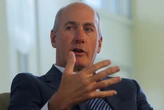This week, biotech Oculogenex landed an early, but essential, endorsement from the Food and Drug Administration (FDA), the company’s CEO and founder Hema Ramkumar told Fast Company, for a therapy to treat an eye-wasting disease that’s the leading cause of irreversible vision loss in elderly Americans. The regulatory milestone isn’t an approval for the drug itself, but a significant “go-ahead” in the minutiae of how any drug is developed that stands on its own merits. It’s an endorsement of Oculogenex’s strategy for a planned mid-stage clinical trial in intermediate age-related macular degeneration (AMD).
But the boilerplate of drug approval bureaucracy isn’t the full story here. It’s just one chapter in a saga of scientific discovery that blends cutting-edge medical and rocket technologies–wherein NASA, SpaceX, Oculogenex, and a few dozen frontier-breaking space-bound mice joined forces to explore the roots of a degenerative disease that robs millions of their eyesight and independence but has few effective treatments–with a boost from the unique advantages microgravity affords researching the retina.
That story began in March, when 40 mice treated with an experimental Oculogenex gene therapy voyaged up to the International Space Station (ISS) on a SpaceX rocket. This, says Ramkumar, a physician-scientist who specializes in complex eye disorders and veteran clinical trial investigator in the space, was a first-of-its-kind mission in gene therapy drug research funded by NASA’s CASIS unit with help from MassChallenge and Boeing to advance Oculogenex’s pipeline for common-but-vexing eye diseases in serious need of exploration.
AMD is a common disease with two distinct forms–wet AMD and dry AMD–but the latter makes up for 85-90% of diagnosed cases, according to the American Macular Degeneration Foundation. Simply put, both kinds of AMD can put you at risk of blurry or impaired vision, though wet AMD is far more severe and might require treatments such as regular eye injections. At that point, abnormal blood vessels beneath the retina begin leaking blood and fluid (hence, “wet” AMD). One biological twist? Dry AMD can eventually morph into wet AMD, and there’s “no treatment for late stage dry AMD,” per the National Institutes of Health (NIH).
AMD research has a long way to go generally, says Ramkumar, especially when it comes to sussing out the exact biological foes that erode your central vision function and stop their irreversible advance.
That research is more complicated on Earth because of how complex the disease is and how it might progress over time; age, diet, and lifestyle choices such as smoking are clear risk factors because they can cause something called “oxidative stress,” a chemical imbalance which leads to cell damage in your eyes.
Ramkumar likens it a bit to how liver disease progresses from inflammation that might not cause any symptoms at first but could eventually lead to cell death that causes irreparable harm; figuring out how to staunch that advance could prove a boon to millions. But there aren’t a lot of ways to quickly emulate the progression of the disease on Earth.
“Usually, to get this kind of mild oxidative stressor in an animal experiment, I was getting several year old animals, aging them, feeding them,” said Ramkumar. “By the way, feeding them McDonalds is a way to get macular degeneration, a high-fat diet. And so all these things were taking way too long. And they were variable.”
But in the microgravity of space, that oxidative stress process appears to ramp up rapidly and result in the kind of retinal damage associated with intermediate dry AMD–the target patient population for Oculogenex’s experimental gene therapy which the space-bound mice received before takeoff.
As fascinating as the interstellar science is, Ramkumar stresses that it’s ultimately an innovative method that’s meant to fill a gap in scientific knowledge and the lives of patients here on the ground (and, yes, some clear implications for the future strategies Oculogenex itself might deploy for its experimental drug pipeline).
“These people often have parents that went blind from the disease, maybe brothers and sisters that are getting injections,” she said. “They’re having trouble seeing in low light conditions, reading the menus in restaurants, trouble reading, barely keeping their driver’s license. Many of these people are living alone and are petrified that they’re about to lose their house and their independence.”
The business of drug development is a fraught endeavor; science can always break your heart, especially for therapies attempting to treat the root causes and not just the symptoms. What Ramkumar and Oculogenex are betting on, and could potentially impact how research scientists and pharma companies at large approach vision loss treatment from the earliest stages, is a clear-eyed view on why it happens in the first place.






No comments